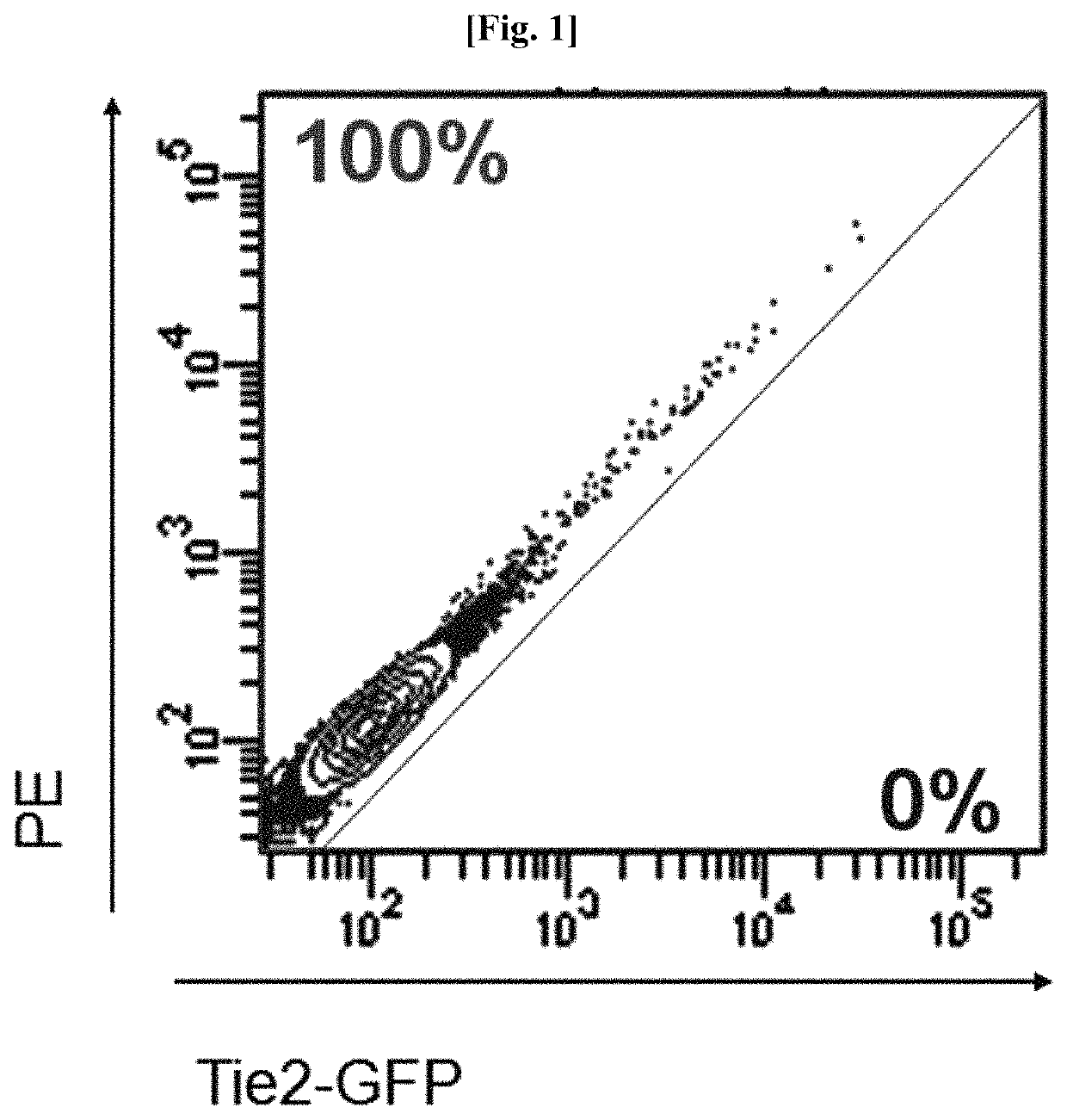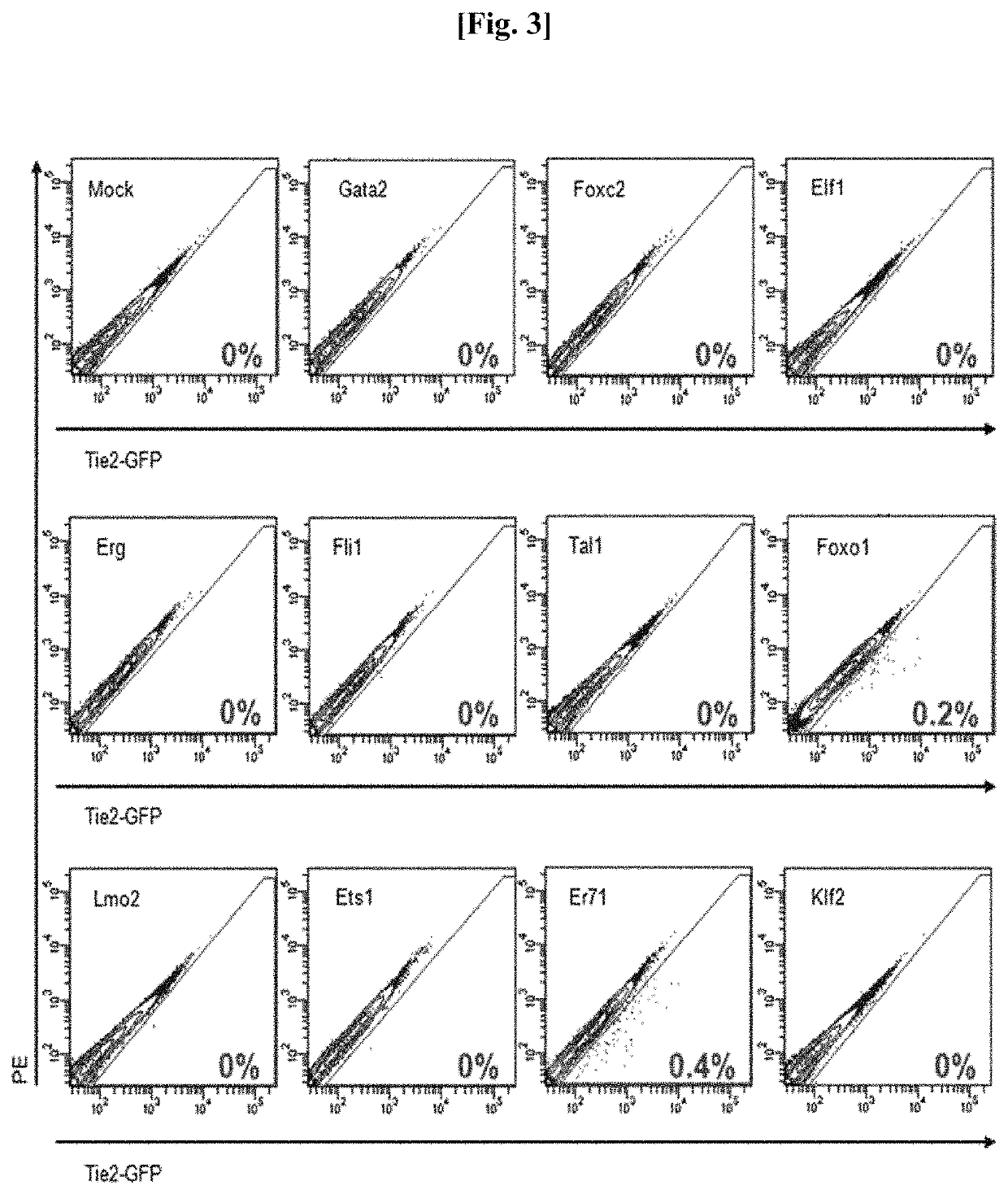Method for preparing of endothelial cells by transformation (transdifferentiation) of adult fibroblast, and use thereof
a technology of endothelial cells and fibroblasts, which is applied in the field of preparation of endothelial cells by transformation (transdifferentiation) of adult fibroblasts, can solve the problems of lack of angiogenesis in the placenta, disease exacerbation, and non-formation of blood vessels
- Summary
- Abstract
- Description
- Claims
- Application Information
AI Technical Summary
Benefits of technology
Problems solved by technology
Method used
Image
Examples
example 1
Selection of Factors for Inducing Transdifferentiation of Adult Fibroblasts into Vascular Endothelial Cells
[0105]The present inventors conducted the following experiments to select optimal factors for inducing transdifferentiation of adult fibroblasts into vascular endothelial cells.
[0106]1-1. Selection of 11 Candidate Genes and Production of Lentivirus for Gene Expression
[0107]The present inventors selected 11 genes which are considered to be key regulators of vascular endothelial development (Table 1), and produced lentivirus for expressing each of the selected genes.
[0108]
TABLE 1Gene symbolNCBI Accession numberGata2NM_008090Foxc2NM_013519Elf1NM_007920ErgNM_133659Fli1NM_008026Tal1NM_011527Foxo1NM_019739Lmo2BC057880Ets1BC010588Er71NM_007959Klf2NM_008452
[0109]In particular, a coding sequence of each gene was amplified by RT-PCR and subcloned into pENTR1A entry vectors (Invitrogen) to create entry clones. Mouse Er71 cDNA was provided by S. Sumanas, mouse Fli1 and Elf1 cDNAs by B. Göt...
example 2
Selection of Five Factors Suitable for Inducing Trans Differentiation of Adult Fibroblasts into Vascular Endothelial Cells
[0118]To investigate whether the 11 factors confirmed in Example 1 were essential to activate the vascular endothelium-specific gene, lentivirus expressing each of the factors was transduced into adult skin fibroblasts.
[0119]As a result, it was confirmed that, only when Foxo1 and Er71 were transduced, Tie2-GFP+ cells were generated (FIG. 3). In addition, it was confirmed that, when Foxo1 and Er71 were combined, the percentage of GFP+ cells was increased to 0.6%. In addition to the two factors, transduction with each factor was continuously performed. As a result, it was confirmed that, when, in addition to the two factors (Foxo1 and Er71), the Klf2 factor was transduced, the proportion of GFP+ cells remarkably increases (FIG. 4).
[0120]In addition, it was confirmed that the proportion of GFP+ cells further increased when, in addition to three factors (Foxo1, Er71,...
example 3
Induction of Differentiation of Vascular Endothelial Cells Using Five Selected Differentiation Induction Factors
[0122]3-1. Induction of Differentiation of Adult Skin Fibroblasts (SFBs) into Vascular Endothelial Cells
[0123]To reconfirm whether the combination of the five differentiation induction factors (Foxo1, Er71, Klf2, Tal1, and Lmo2: 5F) confirmed in Example 2 induced transdifferentiation of adult skin fibroblasts into vascular endothelial cells, an experiment was conducted according to a method illustrated in FIG. 8.
[0124]As a result, it was confirmed that, when the adult skin fibroblasts was transduced with 5F, the activation of the Tie2 promoter was induced in 4.0% of SFBs (FIG. 9) and the resultant cells had a cobblestone shape similar to the shape of vascular endothelial cells (FIG. 10).
[0125]3-2. Induction of Differentiation of Adult Tail-Tip Fibroblasts (TTFs) into Vascular Endothelial Cells
[0126]In addition, to investigate whether 5F exhibited the same differentiation i...
PUM
| Property | Measurement | Unit |
|---|---|---|
| pH | aaaaa | aaaaa |
| adhesion | aaaaa | aaaaa |
| blood flow rate | aaaaa | aaaaa |
Abstract
Description
Claims
Application Information
 Login to View More
Login to View More - R&D
- Intellectual Property
- Life Sciences
- Materials
- Tech Scout
- Unparalleled Data Quality
- Higher Quality Content
- 60% Fewer Hallucinations
Browse by: Latest US Patents, China's latest patents, Technical Efficacy Thesaurus, Application Domain, Technology Topic, Popular Technical Reports.
© 2025 PatSnap. All rights reserved.Legal|Privacy policy|Modern Slavery Act Transparency Statement|Sitemap|About US| Contact US: help@patsnap.com



